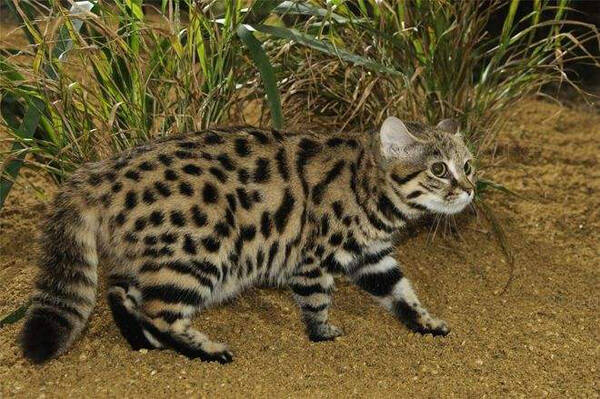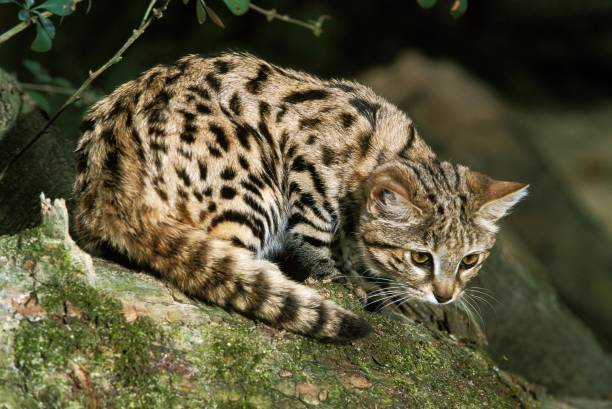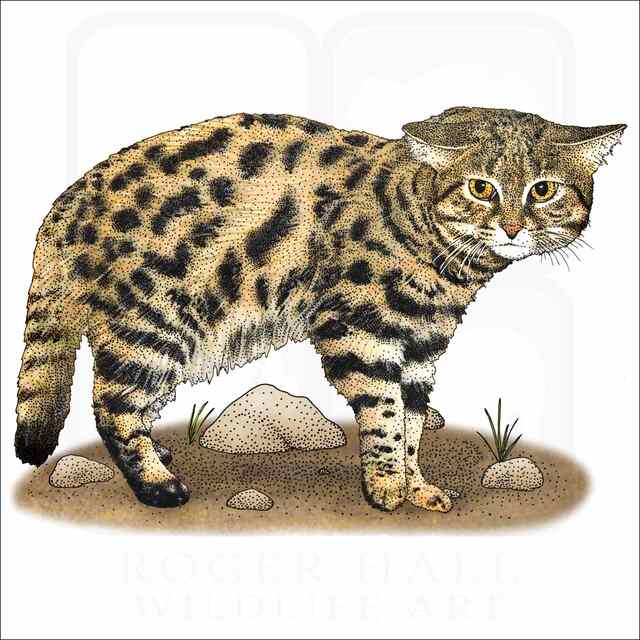Felis nigripes
IUCN
LCBasic Information
Scientific classification
- name:Felis nigripes
- Scientific Name:Black-footed cat,Small tabby cat
- Outline:Carnivora
- Family:Carnivora Felidae Felis
Vital signs
- length:36-52 cm
- Weight:1.3-1.6kg
- lifetime:10-13 year
Feature
The name comes from the black markings on the soles of their feet.
Distribution and Habitat
The black-footed cat is endemic to southern Africa, mainly distributed in South Africa and Namibia, and to a lesser extent in Botswana. There are also small distribution records in the northwest edge of Zimbabwe and the southern area near the South African border. There may also be black-footed cats on the southeast edge of Angola. However, there have never been any distribution records in Lesotho, Mozambique and Swaziland.
The black-footed cat lives only in open short grass habitats, dry savannahs, scrublands and semi-deserts. It does not need drinking water, but cannot survive in the deep deserts with open terrain and extremely dry areas.
Appearance
The black-footed cat weighs an average of 1.6 kg, making it one of the smallest cats. Female cats weigh an average of 1.3 kg, while males are 31% larger than females, weighing 1.9 kg. They are 36 to 52 cm long, with a tail length of 13 to 20 cm and a shoulder height of 25 cm. Their heads are large relative to their bodies.
The black-footed cat has a soft and dense coat, ranging in color from light tea gold to reddish brown, with dark brown or black stripes or dots on the coat, while the chin, chest, abdomen and inner sides of the limbs are lighter in color. Its tail is somewhat similar to that of a tabby house cat, with black stripes around it, and the tip of the tail is also black. It is worth noting that its pads are not only black, but also covered with long black hair to prevent them from getting burned when walking on the hot sand. Of course, its English name is derived from this distinctive black-haired foot.
Details
The black-footed cat (Felis nigripes), named for the black markings on the soles of its feet, is one of the smallest species of wild cats, but can attack lambs four times its size.

Black-footed cat's life habits
Black-footed cats are nocturnal animals. In order to avoid the heat, they hide in termite hills or abandoned holes of other animals during the day and come out to hunt at night. Since there is less food in the desert, these little guys often have to trek more than ten kilometers to fill their stomachs. According to radio telemetry, the activity range of female black-footed cats is as high as 12 square kilometers, and males are even more.
Black-footed cats are small, but they can attack lambs that are four times their size. When attacking, they will jump up and bite the lamb's throat until the vein is pierced by their sharp teeth before jumping down. When the kittens are frightened, they will not run around, but hide on the spot and wait for their mother's message. The kittens are weaned after 6 weeks and can catch prey on their own.
Black-footed cats are also solitary nocturnal walkers. They mark their territory with urine and feces. There are multiple females in the territory of a male. At night, the calls of black-footed cats are very loud. Black-footed cats are very shy animals. They will try to hide, but when they are surrounded, they will fiercely protect themselves. Black-footed cats are very fierce. Local residents in Botswana even believe that black-footed cats can knock down an adult giraffe.

Diet of the Black-footed Cat
The Black-footed Cat preys mainly on small prey, such as rodents and small birds, but also on white-winged bustards and hares. The Black-footed Cat eats invertebrates, rodents, birds, reptiles and their eggs. 50% of their diet is made up of various spiders, and males can catch hares. Black-footed Cats can eat food equivalent to 1/5 of their body weight in one night, and sometimes they can preserve food. Some Black-footed Cats have been observed biting small Springbok to death. The main source of food for black-footed cats is rodents, which account for 2/3 of their diet. A black-footed cat can kill 3,000 rodents a year. In addition to rodents and birds, they also eat insects, bird eggs, reptiles, etc. Due to the dry living area, these foods are also their main source of water. A one-year-old female black-footed cat will occupy a territory of about 10 square kilometers, while a male cat will occupy about 22 square kilometers. The territory of an adult male cat overlaps with the territory of 1-4 female cats. They will travel 8 kilometers at night to find food. They need very high energy to survive, requiring 250 grams of food every night, which is one-fifth of their body weight.
Black-footed cat's interspecific relationship
The natural enemies of black-footed cats include caracals, wild cats, jackals, domestic dogs and birds of prey. In order to deal with these natural enemies, black-footed cats not only have to be careful to avoid them, but also have developed a very ferocious and aggressive temperament. This is a self-defense strategy of "attack as defense". Scholars have observed that a female black-footed cat weighing 1.5 kg successfully defended herself against a black-backed jackal that weighed 8 times more than herself. According to zoo keepers, black-footed cats are far more ferocious than other small cats and are notoriously unruly, even newborn cubs are like this.

There is a special symbiotic relationship between black-footed cats and swamp-eared owls. Swamp-eared owls will follow black-footed cats to hunt, and rush down to take away the startled prey before the black-footed cats attack the prey. In this symbiotic relationship, only swamp-eared owls benefit, while black-footed cats are harmful.
Black-footed cat's breeding method
Black-footed cats breed between August and September every year, and the female's estrus period during this period is only 5 to 10 hours. When they are 12 to 20 months old, black-footed cats enter the stage of sexual maturity. Like most cats, black-footed cats are solitary animals. Females and males only come together when mating. After 63 to 68 days of gestation, females will give birth to 1 to 4 litters of kittens and raise them alone. In order to avoid natural enemies, they have to change nests frequently during the period of raising kittens. After 3 months, the kittens can leave the mother cat and live independently. In the spring, summer and autumn of the southern hemisphere, female cats can give birth to two litters. Kittens can be independent at about 5 months old, but they will still live in the mother cat's territory. The life span of artificially fed black-footed cats is 13 years.

Black-footed cat's population status
The survival status of black-footed cats is worrying. They are already scarce in number. Not only do they need to face the threat brought by human activities, but they often become victims of poisoned caracals. In addition, there are many carnivores that pose a threat to black-footed cats. Jackals, snakes, and large owls may cause their death. They also need to face a new threat: hybridization with domestic cats dilutes their bloodline. The American Association of Zoos and Aquariums (AZA) compared and studied the cats in 218 zoos and aquariums and established the Cat Survival Plan (SSPs) for the black-footed cat. The main task of SSPs is to maintain the population of captive species within 50 to 100 years and to ensure their genetic diversity. Therefore, relevant personnel and institutions need to work together to ensure the population of SSPs and related research can proceed smoothly. South Africa and Botswana have taken comprehensive protection measures for them, and CITES has also listed them as vulnerable animals.
Since 2002, the World Conservation Union (IUCN) has classified the black-footed cat as a vulnerable (VU) species.
Listed in Appendix I, Appendix II and Appendix III of the Convention on International Trade in Endangered Species of Wild Fauna and Flora (CITES) 2019 Edition Appendix I.
Protect wild animals and stop eating game.
Maintaining ecological balance is everyone's responsibility!








